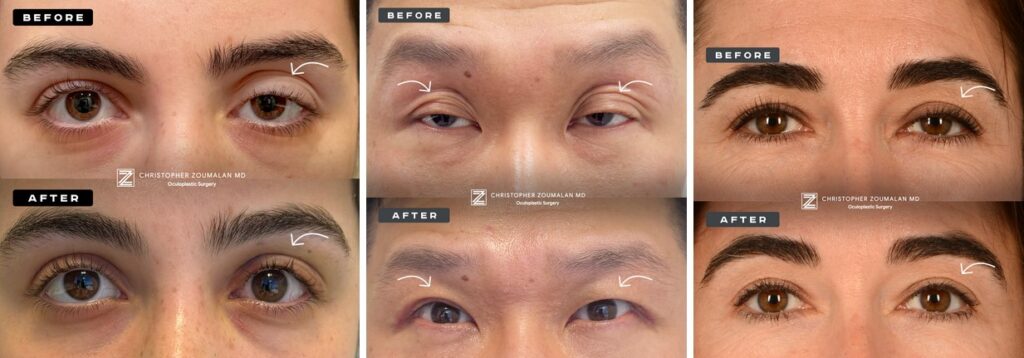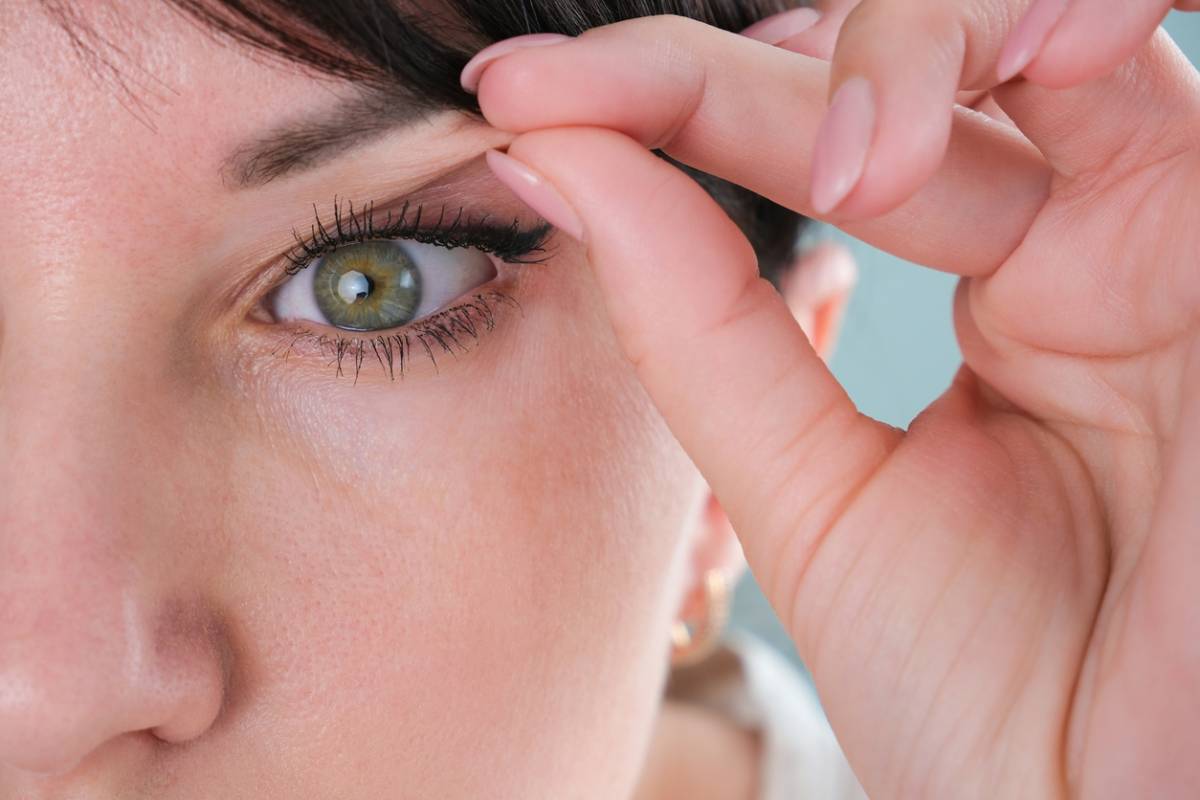Many people notice their upper eyelids becoming heavier or lower over time, leading to a tired, aged, or asymmetric appearance. But not all eyelid drooping is the same. In fact, there’s an important distinction between hooded, sagging eyelids and a medical condition known as ptosis (pronounced “toe-sis). Understanding the difference is an essential first step in evaluating which surgical procedure may be right for you.
Hooded Eyelids or Ptosis: The Difference
What Are Hooded Eyelids?
Hooded eyelids are typically caused by excess skin (known as dermatochalasis) that hangs over the natural crease of the eyelid. This condition is most often due to genetics or aging and does not involve the muscles that lift the eyelid. A hallmark of hooded eyelids is when there is extra skin that folds down from the brow bone over the upper eyelids. Hooded eyelids can give a tired appearance and make it harder to apply makeup.

Upper Eyelid Surgery for Hooded Eyelids
An upper eyelid blepharoplasty addresses hooded eyelids by removing this excess skin to restore a more defined, youthful eye. This procedure does not directly affect the muscles involved in opening the eyelid. It restricts its focus to removing excess skin. However, this alone creates a subtle yet impressive improvement in the appearance of the eyes.
“I recently went through an upper blepharoplasty with Dr. Zoumalan. I was beyond pleased with the results, and Dr. Zoumalan is an extremely gifted and talented surgeon. He took 20 years off my eyes, and his staff is just as amazing. Nicest and kindest individual with a God-given talent for eye surgery. I will forever be grateful for Dr. Zoumalan! He is truly exceptional and the best in the oculoplastics field.”
– Actual Patient, July 2025
What Is Ptosis?
Ptosis refers to the actual lowering of the upper eyelid margin–the edge where your eyelashes are. Unlike hooded eyelids caused by excess skin, ptosis is caused by weakness or dysfunction of the levator muscle and/or the loosening or detaching of the levator tendon that connects that muscle to the eyelid. The levator muscle is the primary muscle responsible for lifting the upper eyelid. Ptosis can affect one or both eyes and varies in severity, from barely noticeable to significantly impairing vision.
There are several types of ptosis, and the most common include congenital, age-related (aponeurotic), and mechanical.
Congenital Ptosis
Congenital ptosis is present from birth and results from incomplete development of the levator muscle.
Aponeurotic Ptosis
Aponeurotic ptosis usually develops later in life and results from the gradual weakening of the levator muscle and tendon over time. Prolonged contact lens wear can also cause aponeurotic ptosis from the repeated insertion and removal of contact lenses.
Mechanical Ptosis
Mechanical ptosis happens when something physically weighs the eyelid down, making the lid droop. Wearing heavy false eyelashes can contribute to mechanical ptosis.
Ptosis Repair for Restored Eyelid Function

Ptosis surgery corrects this condition by tightening or reattaching the levator muscle/tendon, allowing the impacted eye(s) to open more fully. It does not remove excess skin. Instead, it focuses solely on restoring eyelid function, which leads to a more open appearance to the eye.
“I literally can’t say enough great things about this experience, Dr. Zoumalan and his team. I was and am very lucky to have been referred to him, and I encourage anyone seeking to correct ptosis to give him and his team a visit.”
– Actual Patient, October 2024
Which Procedure Do You Need?
If your eyelid skin is drooping, then you may be a candidate for an upper eyelid blepharoplasty. If your eyelid margin (lash line) is drooping, then you may be a candidate for ptosis repair. Many times, patients have both conditions, meaning they may benefit from a combination of ptosis correction and blepharoplasty. Dr. Christopher Zoumalan can address both issues during a single surgery; this approach can be more efficient and may result in better overall aesthetic outcomes.
Expert Guidance from an Oculoplastic Surgeon
When considering eyelid surgery, it’s essential to consult with a highly experienced oculoplastic surgeon. At Dr. Christopher Zoumalan’s practice, we begin with a complimentary photo assessment to help patients understand what’s contributing to their eyelid concerns. He will determine if you have hooded eyelids or ptosis. From there, he will evaluate whether surgery may be appropriate.
Assessing Condition Severity
Once a consultation is scheduled, Dr. Christopher Zoumalan will conduct a comprehensive examination to determine the cause and assess the severity of your condition. This evaluation includes:
- Measuring the height of your eyelids
- Assessing the function of the levator muscle
- Testing your visual field to determine how much the drooping eyelid is affecting your vision
Visualizing Your Results
Dr. Zoumalan will also manipulate your upper eyelids so that you can visualize what your results will look like. This thorough assessment is crucial for determining the most appropriate surgical approach and predicting the likely outcome of treatment.
Start with a Complimentary Assessment
Submit your photos for a complimentary assessment by Dr. Christopher Zoumalan and find out if upper blepharoplasty, ptosis repair, or a combination of procedures is right for you.
“Dr. Zoumalan is truly exceptional. What sets him apart is the incredible amount of time and care he puts into every aspect of your treatment. His attention to detail, patience, and genuine care for his patients are unmatched. The results exceeded my expectations!”
– Actual Patient, June 2024
*Quotes have been edited for clarity and length.
Schedule a Consultation with Dr. Christopher Zoumalan
Dr. Christopher Zoumalan is a board-certified oculoplastic surgeon who specializes exclusively in eyelid procedures, including both upper eyelid blepharoplasty and ptosis correction. With over 17 years of experience and advanced fellowship training, Dr. Zoumalan is uniquely qualified to evaluate the delicate anatomy of the eyelids and create bespoke surgical plans to achieve your goals.

